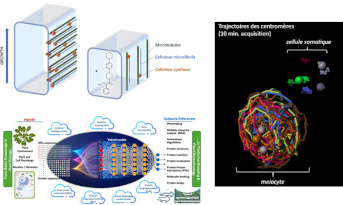IJPB Highlights from Life Sciences at Paris-Saclay University
The three most recent ones
A new cellulose synthesis inhibitor affecting the secretion of cellulose synthase complexes and microtubule dynamics, 10/8/24
In a study published in Plant Physiology, scientists from the "Glycans and Signaling" GAS team discovered a new cellulose biosynthesis inhibitor (CBI), P4B (2-phenyl-1-[4-(6-(piperidin-1-yl)pyridazin-3-yl)piperazin-1-yl)butan-1-one), through a chemical screen aimed at identifying molecules capable of inhibiting the growth of Arabidopsis thaliana. They also isolated the cesa3pbr1 mutant, which is affected in the gene encoding the catalytic subunit of cellulose synthase CESA3 and shows partial resistance to P4B. The action of P4B differs from that of other CBIs, and this inhibitor may directly target CESA3.
> More
Language models to enhance the understanding of molecular mechanisms in plants, 9/17/24
Scientists from the “Germination Physiology“ PHYGERM team, in a study published in Plant Cell Reports, explored the contribution of deep learning methods, particularly large language models (LLMs), to plant biology. These approaches enable in-depth analyses of nucleic acid and protein sequences, facilitating the recognition of complex structures, functions, and molecular interactions within plant systems. This review highlights the potential of LLM-based approaches to advance research in plant biology, support agricultural production, and contribute to sustainable agroecological and agri-food transitions.
> More
Admiring the real-time ballet of chromosomes during meiosis, 9/10/24
Sexual reproduction relies on the alternation of phases where parental chromosomes pair up (fertilization) and then separate (meiosis, gamete formation). For the balanced separation of chromosomes during meiosis, it is essential that the parental (homologous) chromosomes recognize and pair with each other. Any disruption of this pairing can lead to severe sterility issues in the parents or chromosomal abnormalities in the offspring. How parental chromosomes recognize each other in a nuclear space crowded with non-homologous chromosomes and pair without causing harmful entanglements remains a major mystery. In a study published in Nature Communications, scientists from the " Meiosis Mechanisms" MeioMe and "Modeling and Digital Imaging" MiN teams revealed for the first time in the plant Arabidopsis thaliana that chromosomes exhibit extremely rapid movements during this search and pairing phase, as if they are being violently shaken within the nuclear space. The results demonstrate the conservation of these meiotic chromosomal movements in plants and establish A. thaliana as a new model species for their functional study.
> More
> See also IJPB news
In a study published in Plant Physiology, scientists from the "Glycans and Signaling" GAS team discovered a new cellulose biosynthesis inhibitor (CBI), P4B (2-phenyl-1-[4-(6-(piperidin-1-yl)pyridazin-3-yl)piperazin-1-yl)butan-1-one), through a chemical screen aimed at identifying molecules capable of inhibiting the growth of Arabidopsis thaliana. They also isolated the cesa3pbr1 mutant, which is affected in the gene encoding the catalytic subunit of cellulose synthase CESA3 and shows partial resistance to P4B. The action of P4B differs from that of other CBIs, and this inhibitor may directly target CESA3.
> More
Language models to enhance the understanding of molecular mechanisms in plants, 9/17/24
Scientists from the “Germination Physiology“ PHYGERM team, in a study published in Plant Cell Reports, explored the contribution of deep learning methods, particularly large language models (LLMs), to plant biology. These approaches enable in-depth analyses of nucleic acid and protein sequences, facilitating the recognition of complex structures, functions, and molecular interactions within plant systems. This review highlights the potential of LLM-based approaches to advance research in plant biology, support agricultural production, and contribute to sustainable agroecological and agri-food transitions.
> More
Admiring the real-time ballet of chromosomes during meiosis, 9/10/24
Sexual reproduction relies on the alternation of phases where parental chromosomes pair up (fertilization) and then separate (meiosis, gamete formation). For the balanced separation of chromosomes during meiosis, it is essential that the parental (homologous) chromosomes recognize and pair with each other. Any disruption of this pairing can lead to severe sterility issues in the parents or chromosomal abnormalities in the offspring. How parental chromosomes recognize each other in a nuclear space crowded with non-homologous chromosomes and pair without causing harmful entanglements remains a major mystery. In a study published in Nature Communications, scientists from the " Meiosis Mechanisms" MeioMe and "Modeling and Digital Imaging" MiN teams revealed for the first time in the plant Arabidopsis thaliana that chromosomes exhibit extremely rapid movements during this search and pairing phase, as if they are being violently shaken within the nuclear space. The results demonstrate the conservation of these meiotic chromosomal movements in plants and establish A. thaliana as a new model species for their functional study.
> More
> See also IJPB news
Back
